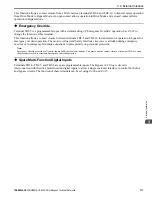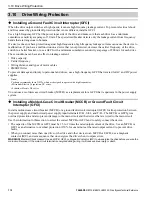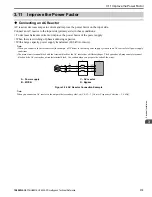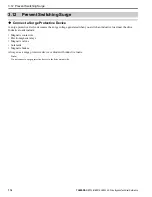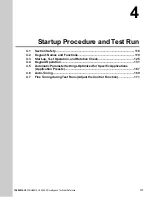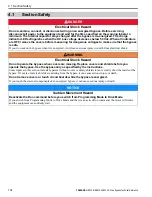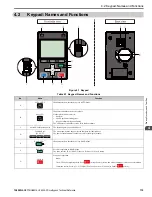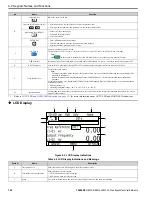
4.3 Start-up, Test Operation, and Rotation Check
YASKAWA
SIEPYAIH6B01A HV600 AC Drive Bypass Technical Reference
125
4.3
Start-up, Test Operation, and Rotation Check
This section gives the basic steps necessary to get the bypass started and make sure the motor spins in the correct
direction. This section gives information about only the most basic settings.
◆
Items to Check before You Energize the Bypass
1.
Make sure there is no power to the bypass. Use a properly rated and functioning multimeter to make sure that
it is safe and do all appropriate lockout/tagout procedures.
WARNING!
Electrical Shock Hazard. Do not operate the bypass when covers are missing. Replace covers and shields
before you operate the bypass. Use the bypass only as specified by the instructions. Some figures in this section include
bypasses without covers or safety shields to more clearly show the inside of the bypass. If covers or safety shields are
missing from the bypass, it can cause serious injury or death.
2.
Record the motor nameplate information and make sure that the input voltage aligns with the bypass rating.
Make sure that the motor rated FLA is not more than the output current rating of the bypass as shown on the
bypass nameplate.
Make sure that the motor rated FLA is in range of the specifications. Refer to
for
information.
3.
The bypass will have one of two types of main input disconnect:
A non-fusible disconnect switch
The standard bypass includes a non-fusible disconnect switch that does not provide branch circuit protection.
If you will be installing the bypass according to applicable local codes and the requirements shown on the
bypass nameplate, you must install appropriate branch circuit protection. Yaskawa recommends
semiconductor fusing to ensure 100 kAIC SCCR panel rating. This fusing is specified on the bypass
nameplate.
WARNING!
Fire Hazard. You must install branch circuit protection according to applicable local codes and the
requirements listed on the bypass nameplate. The bypass is suitable for use on a circuit capable of delivering not more
than 100,000 RMS symmetrical amperes, 208 Vac and 480 Vac with the circuit breaker option or when protected by class
J or class L fuses as specified on the bypass nameplate. Consult factory with questions. Failure to comply could result in
fire and damage to the bypass unit or injury to personnel
An input circuit breaker
Bypass Option M includes an input circuit breaker. You must use the two dials on the circuit breaker to set the
adjustable trip level. The dial marked “FLA” sets the breaker to match the motor FLA. Use a small straight-
edge screwdriver and adjust to the appropriate current level. The other dial sets the inrush level. Make sure
this dial is set to “Auto 1” (factory setting).
4.
Make sure that the available three-phase line power is the correct voltage. Connect line power to the input
disconnect device.
5.
Connect the bypass grounding terminal to the appropriate building ground circuit.
6.
If you are using a dual voltage motor, make sure that the motor is wired for the application voltage.
7.
Connect the motor to the output terminal block in the bypass or to the motor overload (if provided).
8.
Connect the motor ground to the bypass drive ground terminal.
9.
If you have an external motor overload, set the correct FLA from Step 2 there.
10.
Use the connection diagram or the schematic packaged with the bypass to make sure that you correctly
terminate wiring connections and connected to appropriate circuits at PCB A2. Please note the following with
respect to the safety circuit (DI-2, terminal TB2-2) and the BAS interlock circuit (DI-3, terminal TB2-3):
Safety Interlock Circuit
DI-2 (terminal TB2-2) is provided to connect safety devices in a normally-closed series circuit, such as: freeze
up thermostats, smoke/fire sensors, high pressure limits, temperature limits, or vibration detectors.
If a N.C. safety circuit is not closed between DI-2 (TB2-2) and IG24 (TB2-10) on PCB A2 at power-up, the
HOA keypad will show a “Safety Open” message. An open circuit between DI-2 (TB2-2) and IG24 (TB2-10)
will prevent bypass operation.
Take one of the following steps to ensure proper operation prior to startup:
• Install a N.C. safety circuit between DI-2 (TB2-2) and IG24 (TB2-10) on PCB A2.
or
• Install a jumper between DI-2 (TB2-2) and IG24 (TB2-10) on PCB A2.
Summary of Contents for H6B1A002
Page 12: ...12 YASKAWA SIEPYAIH6B01A HV600 AC Drive Bypass Technical Reference...
Page 74: ...Page Intentionally Blank...
Page 76: ...Page Intentionally Blank...
Page 454: ...5 14 Z Bypass Parameters 454 YASKAWA SIEPYAIH6B01A HV600 AC Drive Bypass Technical Reference...
Page 590: ...8 6 Storage Guidelines 590 YASKAWA SIEPYAIH6B01A HV600 AC Drive Bypass Technical Reference...
Page 780: ...11 3 European Standards 780 YASKAWA SIEPYAIH6B01A HV600 AC Drive Bypass Technical Reference...

